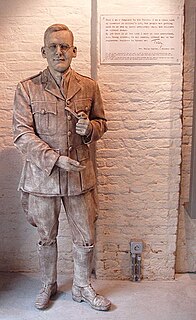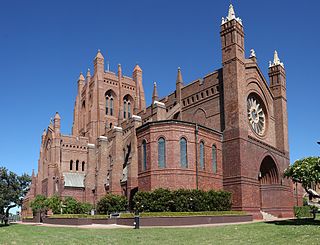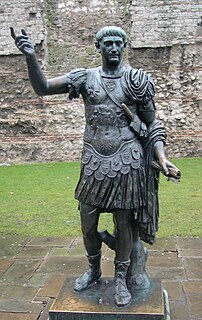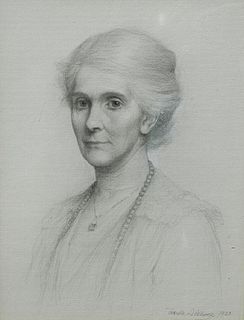
Poperinge is a municipality located in the Belgian province of West Flanders, Flemish Region, and has a history going back to medieval times. The municipality comprises the city of Poperinge proper and surrounding villages. The area is famous for its hops and lace.

All Hallows-by-the-Tower, at one time dedicated jointly to All Hallows and the Virgin Mary and sometimes known as All Hallows Barking, is an ancient Anglican church on Byward Street in the City of London, overlooking the Tower of London.

The Royal Army Chaplains' Department (RAChD) is an all-officer corps that provides ordained clergy to minister to the British Army.
Tubby is a nickname and surname and may refer to:

Sanctuary Wood Cemetery is a Commonwealth War Graves Commission (CWGC) cemetery for the dead of the First World War, 5 km east of Ypres, Belgium, near Hooge in the municipality of Zillebeke. Located off the main Ypres-Menin Road on Canadalaan. The Canadian Hill 62 Memorial is 100 metres further down the road from the cemetery.

The Reverend Philip Thomas Byard Clayton, known as "Tubby" Clayton, was an Anglican clergyman and the founder of Toc H.
Talbot House may refer to:

The Liberties of the Tower, or the Tower Liberty is a small neighbourhood in the London Borough of Tower Hamlets, East London, which includes both Tower Hill and the Tower of London. The area was defined sometime after 1200 to provide an open area around the Tower to ensure its defensibility. The Liberty was an independent administrative unit from then until 1900, when it joined the former Metropolitan Borough of Stepney.

Neville Stuart Talbot MC was Bishop of Pretoria in the Anglican Church of Southern Africa and later a robust vicar of St. Mary's Church, Nottingham and assistant Bishop of Southwell who turned down the chance to be Bishop of Croydon. He was born at Keble College, Oxford, and died at Henfield, Sussex.

Dame Meriel Lucy Talbot, was a British public servant and women's welfare worker. During the First World War, she organised the Women's Land Army and edited their magazine The Landswoman.

Cuthbert Killick Norman Bardsley was an Anglican bishop and evangelist who served as Bishop of Croydon from 1947 to 1956 and Bishop of Coventry from 1956 to 1976. It was during his tenure at Coventry that the new cathedral was consecrated, following the destruction of its 14th-century predecessor during the Second World War.

Edward Stuart Talbot was an Anglican bishop in the Church of England and the first Warden of Keble College, Oxford. He was successively the Bishop of Rochester, the Bishop of Southwark and the Bishop of Winchester.
Gilbert Talbot may refer to:
The Reverend Frederic Michael Anderton was an English clergyman, distinguished Jungian analyst and a first-class cricketer who played for Cambridge University Cricket Club.

The Cathedral Church of Christ the King, also called Christ Church Cathedral, is an Australian cathedral in Newcastle, New South Wales. It is the cathedral church of the Diocese of Newcastle in the Anglican Church of Australia. The building, designed by John Horbury Hunt in the Gothic Revival style, is located on a hill at the city's eastern end in the suburb called The Hill. It was added to the New South Wales State Heritage Register on 28 June 2011.

Rupert Edward Inglis was an England international rugby player who later became a Church of England rector. During the First World War, Inglis was a chaplain to the British Army and was killed during the Battle of the Somme.

The statue of Trajan is an outdoor twentieth-century bronze sculpture depicting the Roman Emperor Trajan, located in front of a section of the London Wall built by Romans, at Tower Hill in London, United Kingdom.

Hon. Lavinia Lyttelton was a British promoter of women's education in the United Kingdom.
Coleman Jennings was an American philanthropist, religious leader, and businessman. He had an early career in the banking and finance field before retiring early to focus on philanthropy and community work. He founded the Washington, D.C. branch of Toc H and, in the late 1930s and early 1940s, was the president of the Community Chest of Washington, which later became a part of the United Way of America. Jennings was also a layman and speaker in the Episcopal Church.

Tower Beach was an urban beach on the north bank of the River Thames in London, England, adjacent to the Tower of London, which was open to the public from 1934 to 1971.

















